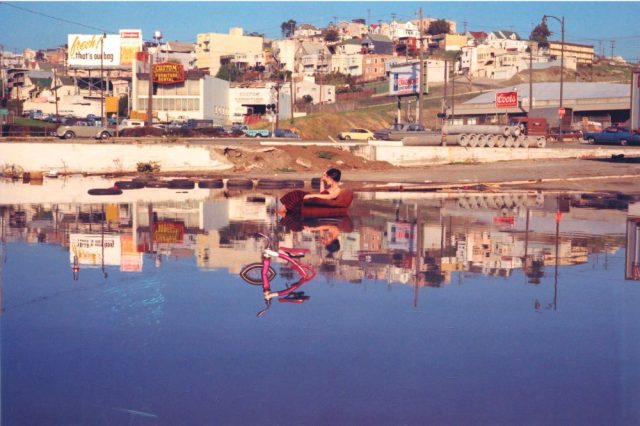“Bonnie Ora Sherk: Life Frames since 1970” is the first posthumous solo exhibition and first major survey in the Bay Area of the late artist’s work as an environmental educator and landscape planner. From parklets to on-ramps, the exhibition highlights Sherk’s seminal impact on reclaiming urban space for community engagement.
POP-UP URBANISM CREATOR
Sherk is recognized as a key figure among the first generation of Conceptual Art and performance artists in California and the alternative or artist-run space movement of that era. Originally from Massachusetts, Sherk spent her formative years in New Jersey and moved to the West Coast in the late 1960s, where she enrolled in an MFA program at San Francisco State University. “Bonnie Ora Sherk: Life Frames since 1970” traces the direct relationship between the artist’s work in the 1970s to the parklets of today. Her history is presented through a range of projects and installations.
LANDSCAPE-SPACE ART
This exhibition presents newly transferred film and video as well as rarely seen photographs, collages, works on paper, artist books, printed matter, and ephemera of Sherk’s early performances and site-specific interventions from the 1970s and 1980s. Sherk’s first public installation was Portable Parks I–III (1970), which transformed a series of “dead” urban spaces into green living environments. In San Francisco, Portable Parks I–III included the former James Lick freeway that crossed over Market Street; two concrete islands adjacent to the Mission/Van Ness off-ramp, and the whole street of Maiden Lane between Stockton Street and Grant Avenue. Complete with sod, palm trees and live animals, the spaces won critical acclaim and presaged the pop-up urbanism movement decades later.
Photos from performance art events like Sitting Still 1 will be on display as another demonstration of environment transformation. Sitting Still 1 shows the artist in an evening gown placing herself in a discarded overstuffed armchair in an area where garbage and water collected near a construction site. The act of posing in the chair in a gown transformed the garbage dump into classic fine art portraiture, and the passersby in their automobiles became the audience.
THE FARM
For the exhibition, Sherk’s best-known project, Crossroads Community (the farm), which existed from 1974 to 1980, will be pictured through video, photography, and posters spanning the hands-on activities of the community tending the land to photos of art events including circus and dance performers. As a multiarts center and environmental education farm, the space functioned as a community meeting place located underneath a major freeway interchange in San Francisco at the former location of a dairy farm. The seven-acre eco-garden and art space united parcels of land across four neighborhoods bisected by the freeway. The farm engaged multigenerational neighbors and school children throughout the city and played host to visual, performing arts, and music communities until 1987. Land transformation merged with community involvement and reinforced a connection to nature. Amidst the vegetable and flower gardens, The Farm was also home to domestic animals who lived in The Raw Egg Animal Theater.
A LIVING LIBRARY
“Before her passing, Sherk enjoyed a resurgence of interest in her pioneering work in the public sphere and its legacy for contemporary art, from ecofeminism to social practice,” said Tanya Zimbardo, guest curator. “It is an honor to be able to offer an in-depth look at the evolution of her ideas, which will resonate with a range of community gardening, food justice, and environmental sustainability initiatives today in the Bay Area.”
Today, Sherk’s bicoastal nonprofit A Living Library, established in 1981, continues her vision for community-oriented environmental projects located on Roosevelt Island in New York City, and Bernal Heights and OMI/Excelsior in San Francisco. The nonprofit brings together community members and youth to restore native habitats, create educational gardens, plant trees, and bring daylight to San Francisco’s Islais Creek watershed. Her presence continues to be felt in the eco-art movement and its emphasis on the interdependent relationships between humans, animals, and nature.
Closing out the exhibition’s run will be a celebration of the Fort Mason Center for Arts and Culture-produced first significant catalog dedicated to Sherk, and a pop-up urbanism/urban planning symposium in March 2024.
Bonnie Ora Sherk: Life Frames since 1970: Jan. 13–March 10, Free, Gallery 308, Landmark Building A, Fort Mason Center for Arts & Culture, 2 Marina Blvd., 415-345-7500, fortmason.org
Sharon Anderson is an artist and writer in Southern California. She can be reached at mindtheimage.com.





